Original Post: March 6, 2019
by Eric Marturano
For the past 5 years, I’ve been attending the MIT Sloan Sports Analytics Conference. I started going back in 2014, when I was a senior at Boston College (and called color & play-by-play for the football and men’s basketball teams on WZBC student radio). Since then, I haven’t stopped going – and for good reason. The MIT Sloan Sports Analytics Conference is not only a super-fun event but an annual excuse for me to visit some friends who have been stranded in the terrible town of Boston. Since one of the first things I wrote for PFO was actually based off of a presentation I saw there in 2018, I thought it might be nice to share some highlights from 2019. Without further ado, here are my Views from the 13th Annual MIT Sloan Sports Analytics Conference!
by Eric Marturano
For the past 5 years, I’ve been attending the MIT Sloan Sports Analytics Conference. I started going back in 2014, when I was a senior at Boston College (and called color & play-by-play for the football and men’s basketball teams on WZBC student radio). Since then, I haven’t stopped going – and for good reason. The MIT Sloan Sports Analytics Conference is not only a super-fun event but an annual excuse for me to visit some friends who have been stranded in the terrible town of Boston. Since one of the first things I wrote for PFO was actually based off of a presentation I saw there in 2018, I thought it might be nice to share some highlights from 2019. Without further ado, here are my Views from the 13th Annual MIT Sloan Sports Analytics Conference!
Thursday, February 28th, 2019
I caught a train from 30th Street Station in Philadelphia as my ride up, a day ahead of the conference. This year, I was glad to joined by PFO’s very own Jason Blevins, who met me on the 6+ hour Amtrak trek to Boston. On the way up, we chatted mostly about the Sixers, who were playing the Thunder that evening (and ended up beating for the first time since 2008!). We also chatted about Bryce Harper, some bum who wants to be in Philadelphia until he’s ready to retire. Having a friend on a long trip is always good, so I highly recommend traveling that way if you can – especially if you’re headed to the hellscape that is Boston.
Once we arrived in Boston, we split up to go to our respective lodging areas. I stayed in Brookline with some friends I met during my time at Boston College (big thanks to Jon, Sarah, Joseph, & Alyson for having me), which made for an easy commute to the Hynes Convention Center the next day.
Friday, March 1st, 2019
I awoke early the next day – I’m talking like 6:30am. The conference is a full two-day event, with the first day of panels running 7:00am – 6:30pm and the next day running nearly as long (7:45am – 6:00pm). Since the Welcome Remarks didn’t begin until 8:00am, I showed up for registration/breakfast around 7:30am to meet up with Jason. As per usual, the Welcome Remarks featured the Dean of MIT Sloan School of Management, Jessica Gelman, & Daryl Morey. Gelman & Morey co-founded the conference in 2006, and by all accounts, it’s been a blast ever since.
Before I dive into my personal itinerary for the duration of the conference, I want to mention that many of the higher profile panels & sessions can be found on video here. The agendas for each day can be found here. As an attendee, I very much appreciate that the conference records many of the sessions since occasionally there will be two panels of interest going on at the same time, and as an attendee, you’re forced to pick only one (and miss the other). Anyway, here are my Views from Day 1 of the MIT Sloan Sports Analytics Conference from the path that I chose:
8:30am-9:00am Whistle While You Work: Measuring Intangibles of NBA Officials
Speaker(s): Monty McCutchen
Description: NBA referees make more than 4,000 calling decisions each game. But the accuracy of those decisions is only part of what it takes to be a great referee. Come for a candid conversation with Monty McCutchen, the NBA’s Head of Referee Development & Training, to learn about the other performance factors the league considers – from courage to communication – when developing and evaluating referees, as well as the league’s effort to turn those standards of performance into data.
Description: NBA referees make more than 4,000 calling decisions each game. But the accuracy of those decisions is only part of what it takes to be a great referee. Come for a candid conversation with Monty McCutchen, the NBA’s Head of Referee Development & Training, to learn about the other performance factors the league considers – from courage to communication – when developing and evaluating referees, as well as the league’s effort to turn those standards of performance into data.
Reaction:
Although I enjoyed this talk, I wish I could have tracked down Monty afterwards to get more detail on the mechanics of how the referee “intangibles” were actually measured (i.e., is it a former ref/league-office guy like Joey Crawford watching a video post-hoc in Secaucus grading Tony Brothers on a 1-5 scale on his general Assertiveness for an entire game, or just for specific instances, etc.?) Regardless of method, after the Tim Donaghy scandal in 2007 and the legalization of sports gambling last year, it makes sense to me that the NBA would be doing everything it can to measure and track accountability among its officials.
I appreciated McCutchen letting the audience into what qualities are judged for referees – accuracy & mechanics, assertiveness, avoidance, communicative, courageous, firmness, humility, resoluteness, team-driven, & unnecessary. The refs that exceed on these measurable intangibles (sort of an oxymoron, right?) tend to score highly on communicative, courageous, firmness, team-driven, accuracy, & assertiveness and low on avoidance, unnecessary, and resoluteness. This makes sense to me – good refs aren’t afraid to make their point (high assertiveness, low avoidance) but also aren’t too stubborn if they’re really in the wrong (high communicative, low resoluteness). Still though, I wouldn’t mind digging deeper into these models, which seemed to be discussed at an intentionally high-level during the presentation.
9:00am-9:30am When Less is More: How the NBA Could Be More Like Peak TV (presented by ESPN)
Speaker(s): Kevin Arnovitz
Description: Nobody can tell you — not the NBA scheduler, those who work in the NBA offices in New York, nor historians of the game — why the NBA settled on an 82-game schedule, one they’ve maintained for more than 50 years. Even though the best science has persuaded NBA teams to routinely hold out their best talent, while players and fans widely regard the regular season as an interminable preamble to the exciting postseason, the NBA bows to a tradition whose origins are a mystery as the guiding authority. It’s time to consider everything we know about the physical demands of the NBA, the current state of the entertainment marketplace, and the basic laws of scarcity (about which the NFL can teach us a thing or two), and lead a substantive conversation about what would constitute the smartest and most compelling NBA schedule.
Description: Nobody can tell you — not the NBA scheduler, those who work in the NBA offices in New York, nor historians of the game — why the NBA settled on an 82-game schedule, one they’ve maintained for more than 50 years. Even though the best science has persuaded NBA teams to routinely hold out their best talent, while players and fans widely regard the regular season as an interminable preamble to the exciting postseason, the NBA bows to a tradition whose origins are a mystery as the guiding authority. It’s time to consider everything we know about the physical demands of the NBA, the current state of the entertainment marketplace, and the basic laws of scarcity (about which the NFL can teach us a thing or two), and lead a substantive conversation about what would constitute the smartest and most compelling NBA schedule.
Reaction:
This topic warrants its own specific deep-dive, but Kevin Arnovitz convinced me – the NBA season should be shorter. Not only is it a better health proposition for the league’s top-talent (the commonly cited argument), but it also makes NBA games scarcer, driving up demand for each individual game and making you more likely to tune in vs. move your eyeballs to the latest streaming show on Netflix (a lesser-used, but fairly compelling argument). The real questions from here are:
- What’s the ideal amount of schedule reduction (70 games? 58 games? etc.) from a pure entertainment/scarcity standpoint?
- For example, the NFL has 16 appointment-TV games. Obviously, the NBA would want more than that…but how much more?
- What are the associated short-term revenue losses (one less game per year of Steph Curry in my building!) vs. the potential long-term revenue gains (three more years of Steph Curry in my building, even with less appearances per year!).
- This is the point that really moves the needle in anything actually happening. The common complaint around the league from both management and players alike would be a short-term loss in revenue. Is there a way to successfully mitigate that in an effort to build a better long-term product?
As someone who loves the NBA, but is also far more likely to watch re-runs of It’s Always Sunny in Philadelphia over a Hornets-Pistons game on NBATV on any given Tuesday evening, this would be an interesting problem to attempt to solve.
9:45am-10:45am Basketball Analytics
Speaker(s): Howard Beck, Zach Lowe, Mike Zarren, Paul Pierce, Bob Meyers
Description: The game of basketball changes quickly – so in an era of three-point shooting, floor spacing, and versatility, it’s natural to wonder what the next iteration of the game will look like. Forecasting the relative value of future player types will be of the utmost significance for any franchise looking for that one special player to take the next step in their evolution. This panel will examine the ways in which teams are leveraging analytics to answer these questions and address other top-of-mind issues such as lineup optimization, “position-less basketball”, as well as finding and exploiting inefficiencies in an increasingly intelligent NBA.
LINK TO FULL VIDEO
Description: The game of basketball changes quickly – so in an era of three-point shooting, floor spacing, and versatility, it’s natural to wonder what the next iteration of the game will look like. Forecasting the relative value of future player types will be of the utmost significance for any franchise looking for that one special player to take the next step in their evolution. This panel will examine the ways in which teams are leveraging analytics to answer these questions and address other top-of-mind issues such as lineup optimization, “position-less basketball”, as well as finding and exploiting inefficiencies in an increasingly intelligent NBA.
LINK TO FULL VIDEO
Reaction:The first morning of Sloan usually has a high-profile basketball panel, which when I first started coming back in 2014 was populated by the likes of anti-Process pariah Stan Van Gundy.
Despite a heavy Celtics contingent (Zarren, Pierce, & Lowe), I found this panel quite enjoyable. Warriors GM Bob Meyers is usually on these sorts of panels each year and tends to say at least one interesting thing. This year, that interesting thing was confirming my long-held belief that GMs seek out and grade players in both the draft and free agency based on if they think that player can play in the playoffs. This isn’t exactly surprising, but to hear it come from a GM vs. a talking head puts some more weight behind it.
In today’s NBA, being “playable in the playoffs” means doing more than just 1 thing well –if you can shoot, you need to also be a passable defender. Stellar defense is your calling card? Find a way to be useful on offense too! As a Sixers season-ticket holder, this hit me a bit as I began to think about the prospect of JJ Redick staying in front of a guard from the Raptors, Celtics, or Bucks in the playoffs. It also applied to Kyrie Irving’s lack of defense potentially costing the Celtics a winnable series in April or May. You take the good with the bad, I suppose.
11:00am-11:30am If You Build It, Will They Come? Driving Value from Fan Experience (presented by Deloitte)
Speaker(s): Sam Ebb
Description: Building on a 15,000 person national survey, we explore key areas of importance, satisfaction, and value drivers for US sports fans across their experience in and around the stadium, as well as while consuming sports content though broadcast and streaming media. We will cover key attributes for teams to consider in their fan engagement strategies, as well as the value of developing an elevated fan experience to create new “fanatics.”
Description: Building on a 15,000 person national survey, we explore key areas of importance, satisfaction, and value drivers for US sports fans across their experience in and around the stadium, as well as while consuming sports content though broadcast and streaming media. We will cover key attributes for teams to consider in their fan engagement strategies, as well as the value of developing an elevated fan experience to create new “fanatics.”
11:30am-12:00pm Creating the Ultimate Fan Experience: Data-Driven Insights on How to Win with Fans Even When Your Team Loses (presented by Qualtrics)
Speaker(s): Mike Maughan
Description: Data clearly shows that when a team wins, fans think the food tastes better, the parking is more convenient, and they get better value for their tickets. When a team loses, the reverse is also true – fans think the same food doesn’t taste as good and the same parking is less convenient. So what can teams do to ensure a great fan experience regardless of whether or not a team wins? Qualtrics ran a series of studies to determine what fans care most about, where they place the most value and what organizations can do to consistently provide great experiences to their fans.
Description: Data clearly shows that when a team wins, fans think the food tastes better, the parking is more convenient, and they get better value for their tickets. When a team loses, the reverse is also true – fans think the same food doesn’t taste as good and the same parking is less convenient. So what can teams do to ensure a great fan experience regardless of whether or not a team wins? Qualtrics ran a series of studies to determine what fans care most about, where they place the most value and what organizations can do to consistently provide great experiences to their fans.
Reaction(s): I’ll lump the more business-y talks I attended together since you came here for sports, but as someone who worked in market research for four years and now works as a manager in the customer experience software space, I got a lot of value out of these discussions:
- Deloitte presented some results from an 8-league fan segmentation study profiling the preferences of all types of fan segments (i.e., Millennial fans are online the most, Generation X fans spend the most on tickets, Baby Boomers are most likely to have TV/Cable subscriptions). They also covered what levers teams can pull to drive revenue, given the relative importance & satisfaction of those levers (i.e., the Atlanta Falcons slashed their concession prices and got more fans to eat & drink inside the stadium ahead of games vs. tailgating in the parking lot).
- Qualtrics followed that presentation up mostly with the results of a conjoint study they did, which derived the relative importance and associated dollar value of things like ticket prices, winning percentage, cleanliness, concessions, merchandise, in-game entertainment, and helpfulness. The results were recommended iterative steps that teams could take to increase their perceived value among their fan-base. This would all be done in an effort to make up for poor performance on the field with stellar performance off of it (i.e., an improvement from “clean” to “very clean” for a fan was shown to be the equivalent of winning 9% of their games, etc.). If you’re wondering why you’re seeing those sad-neutral-happy faces outside the bathrooms at the Wells Fargo Center, stuff like this may be the reason.
12:15pm-1:15pm What does the Fox Say? Analytics in Poker
Speaker(s): Nate Silver, Scott Blumstein, Sunny Mehta, Bill Chen, Maria Konnikova
Description: Given the massive set of possible decision points – 10^14 in Limit Hold ‘em and 10^160 in No-limit Hold ‘em – poker lends itself naturally to the implementation of analytics. Moreover, the rise of analytics’ prominence in poker has somewhat mirrored the rise of analytics in other major professional sports in the 21st century. This panel, led by Nate Silver, brings together a diverse set of backgrounds in analytics and professional gaming that will explore the crossover between these sports and poker – looking into what we can learn from poker that can be applied to sports and sports analytics.
Description: Given the massive set of possible decision points – 10^14 in Limit Hold ‘em and 10^160 in No-limit Hold ‘em – poker lends itself naturally to the implementation of analytics. Moreover, the rise of analytics’ prominence in poker has somewhat mirrored the rise of analytics in other major professional sports in the 21st century. This panel, led by Nate Silver, brings together a diverse set of backgrounds in analytics and professional gaming that will explore the crossover between these sports and poker – looking into what we can learn from poker that can be applied to sports and sports analytics.
Reaction: This was an awesome panel for a lot of reasons – it marked the very first poker panel in the 13 year history of the conference and also happened to feature one of my friends (Scott Blumstein). I met Scott a while back through some of my high school friends (shout-out John, Peter, and Dylan) who went to Temple with Scott, some living with him. A few years later, he won the World Series of Poker Main Event with some of our larger friend group in attendance, and others gathered together watching back here in Pennsylvania. Scott told me he was thrilled to be a part of Sloan this year – conference co-founder Daryl Morey had been in contact with him ever since he won the 2017 Main Event and thought he’d make a good panelist (Daryl was right).
Anyway, listening to someone I’ve heard talk about poker before continue to talk about it in front of a crowd, among other pros was pretty fascinating – the big takeaway for me was to find people who are worse at poker than I am to play against (which my high school friends will tell you is pretty difficult since I am very terrible at poker!). It was interesting to hear the thought processes of some of the best – when to lean on math (which is essentially the barrier to entry as a fundamental in any big tournament) and when to lean on psychology (still a differentiator, notably for Maria Konnikova). At the very least, now when I lose money to my friends, I can be more thoughtful about it.
1:30pm-2:30pm A Behind-the-Scenes look at “NBA Desktop” with Jason Concepcion
Reaction: No official description here, so I’ll try my best – Jason Concepcion of The Ringer hosts a show called “NBA Desktop,” which is essentially like “The Soup” but for NBA Twitter. As someone who runs a podcast, I found it fascinating to observe how this show was filmed and recorded– and they even filmed me, a goofy looking audience member!
This was a great thing to break up the panels with, and I hope to see more “panels” like this in the coming years at Sloan.
2:45pm-3:45pm Who Says No? A 1-on-1 with Adam Silver & Bill Simmons
Speaker(s): Bill Simmons, Adam Silver
Description: Nearing the end of the regular season, Bill Simmons sits one-on-one with commissioner Adam Silver to discuss various basketball – and, in typical Bill fashion, a couple non-basketball – related topics. As Silver enters his sixth year as commissioner, he reflects back on his tenure, discusses the current NBA landscape, and talks about the future of the league. Among other topics they will address tampering in the NBA, tanking, the one-and-done rule, and basketball’s continually increasing world-wide popularity.
LINK TO FULL VIDEO
Description: Nearing the end of the regular season, Bill Simmons sits one-on-one with commissioner Adam Silver to discuss various basketball – and, in typical Bill fashion, a couple non-basketball – related topics. As Silver enters his sixth year as commissioner, he reflects back on his tenure, discusses the current NBA landscape, and talks about the future of the league. Among other topics they will address tampering in the NBA, tanking, the one-and-done rule, and basketball’s continually increasing world-wide popularity.
LINK TO FULL VIDEO
Reaction: I (somewhat shamefully) listen to almost every Bill Simmons Podcast, so this was like a live version of one of those. Bill pressed the commissioner about a number of topics, but the two things that really compelled me out of this discussion came from Adam:
1) Floating the concept of the NBA competing with all other forms of entertainment
1) Floating the concept of the NBA competing with all other forms of entertainment
2) Mentioning that there “isn’t enough [motivation] to win” in the NBA, just the Larry O’Brien (Finals) trophy
The 1st topic brought me back to what Kevin Arnovitz had discussed earlier in the day – a shorter season since the NBA does in fact compete with things like “Making a Murderer” for eye-balls, while the 2nd made me curious if there was a way to make the NBA a better product, independent of cutting games. The fact Adam Silver is open to these is interesting, but I’ll believe it when I see it. He is, after all, the same guy who thought it was a good idea to install Colangelo & Son in the Sixers front office instead of the sacrificial lamb of the Sloan Sports Analytics Conference, Sam Hinkie.
4:00pm-4:30pm Picking Winners in March Madness with Integer Programming
Speaker(s): Tauhid Zaman
Description: We present an algorithm to construct multiple March Madness brackets. Our approach is extremely fast, generating thousands of bracket in minutes. Using simple predictive models for matchups and a clever integer programming formulation, we show that we can rank in the top 10 out of 18 million in the ESPN March Madness contest in 2017 and 2018. We will provide the code for our algorithm for anyone interested in playing in the upcoming tournament.
Description: We present an algorithm to construct multiple March Madness brackets. Our approach is extremely fast, generating thousands of bracket in minutes. Using simple predictive models for matchups and a clever integer programming formulation, we show that we can rank in the top 10 out of 18 million in the ESPN March Madness contest in 2017 and 2018. We will provide the code for our algorithm for anyone interested in playing in the upcoming tournament.
Reaction: A very cool MIT professor named Tauhid Zaman presented a matrix-based algorithm for reasonable bracket diversification – a good enough program to win $50,000 from ESPN’s Tournament Challenge (donated to local charity). He shared the formulas with everyone, so I took some grainy pictures for you in case you also want to take advantage of ESPN’s lack of entry fee (which I have a feeling will soon be changed):
4:30pm-5:00pm Training Schedule Confounds the Relationship between Acute:Chronic Workload Ratio and Injury
Speaker(s): Luke Bornn, Patrick Ward, Darcy Norman
Description: In the past decade, significant efforts have been made to understand injury risk in sport using subjective (i.e. rating of perceived exertion) and objective (i.e. inertial sensor outputs) player-monitoring strategies. Particular focus has been placed on the acute:chronic workload ratio (ACWR), defined as the ratio of average acute (1-week) to chronic (4-week) training loads. In the past 5 years, numerous academic papers across multiple sports have concluded that ACWR is predictive of injury risk, and as a result the ACWR has become standard practice in professional sports to manage player workloads. In this paper, we demonstrate that causal conclusions about the ACWR-injury relationship are prone to confounding from schedule. We use Monte Carlo methods combined with training load data from two sports to illustrate the effect that the yearly training calendar has on the ACWR-injury relationship. We then propose options to mediate this confounding. Our study impacts not only the academic discourse around the ACWR, but also gives practitioners a more realistic expectation of its value in predicting injury.
LINK TO FULL PAPER
Description: In the past decade, significant efforts have been made to understand injury risk in sport using subjective (i.e. rating of perceived exertion) and objective (i.e. inertial sensor outputs) player-monitoring strategies. Particular focus has been placed on the acute:chronic workload ratio (ACWR), defined as the ratio of average acute (1-week) to chronic (4-week) training loads. In the past 5 years, numerous academic papers across multiple sports have concluded that ACWR is predictive of injury risk, and as a result the ACWR has become standard practice in professional sports to manage player workloads. In this paper, we demonstrate that causal conclusions about the ACWR-injury relationship are prone to confounding from schedule. We use Monte Carlo methods combined with training load data from two sports to illustrate the effect that the yearly training calendar has on the ACWR-injury relationship. We then propose options to mediate this confounding. Our study impacts not only the academic discourse around the ACWR, but also gives practitioners a more realistic expectation of its value in predicting injury.
LINK TO FULL PAPER
Reaction: I opted to shift my focus away from research papers in terms of time-spent this year, but they’re often the most interesting things to come out of Sloan. If you’re curious about any of the research papers from this year, they all can be found here. Anyway, I was glad that I was able to fit in actually attending this interesting study, which took on the topic of understanding injury risk. I like studies that attempt to challenge conventional wisdom and accepted norms and sure enough, Bornn, Ward, and Norman raise enough concern around heavily relying on ACWR as a sole means of preventing injury risk that this paper may change how “load management” is handled across sports. As I listened to this, I thought of Joel Embiid, who had been held out for a few extra games – I wonder how much an attention to the effects of training schedule played into the Sixers’ medical staff’s decision to continue to rest him?
5:15pm-6:15pm The People Advantage: Culture Analytics
Speaker(s): Adam Grant, Nate Silver, Daryl Morey, Jessica Gelman
Description: The availability of data today is rapidly expanding, and while this promises to unlock valuable insights for all businesses, many organizations find themselves at a crossroads. While some leaders will boldly turn over all decision-making to AI, others will confidently eschew analytics for gut instinct. There remains a wide spectrum between these extremes, and all leaders need to decide where they stand. How these leaders choose to balance the role of data vs. judgment in their teams will fundamentally shape their organizational culture going forward. On this panel, Adam Grant, Nate Silver, and the SSAC Co-Chairs, Jessica Gelman and Daryl Morey will debate their philosophies on data, organizational culture, and the best way to approach decisions.
Description: The availability of data today is rapidly expanding, and while this promises to unlock valuable insights for all businesses, many organizations find themselves at a crossroads. While some leaders will boldly turn over all decision-making to AI, others will confidently eschew analytics for gut instinct. There remains a wide spectrum between these extremes, and all leaders need to decide where they stand. How these leaders choose to balance the role of data vs. judgment in their teams will fundamentally shape their organizational culture going forward. On this panel, Adam Grant, Nate Silver, and the SSAC Co-Chairs, Jessica Gelman and Daryl Morey will debate their philosophies on data, organizational culture, and the best way to approach decisions.
Reaction: I’ve been on both sides of the interview process before and am generally interested in strategic labor management and team building, so I got some value out of this panel. Panel moderator (and Wharton professor & three-time New York Times best-seller) Adam Grant may have been the most interesting to me, likely due to my extreme familiarity with the other three panelists (it’s impossible to attend Sloan and not listen to at least one panel with Daryl, Jessica, or Nate). Grant was able to get a lot out of the panel and contributed plenty himself.
They quickly moved beyond the cliché “no a-holes” policy that every hirer in the working world says to seem hip and cool and offered some actually interesting strategies for interviewing and being interviewed. One I particularly liked was the concept of “forced negative” questions – rather than asking a candidate about their weakness, provide them a choice between two bad options (i.e., Do you tend to rush through things or take long and extend deadlines?). In this light, you can get some real information. As someone who writes surveys for a living, I enjoyed this.
End of Day 1: Cocktail Reception (presented by KAGR) & SSAC 2019 Official After Party (presented by DraftKings)
One of the best parts of Day 1 of Sloan is the cocktail hour. It’s a chance to meet other people who also decided to go to the hell-town of Boston just because they like sports and math. Each year I have some great conversations, and this year was no different. What was different this year was the addition of the “official” After Party, sponsored by DraftKings at the Grand Boston. After the cocktail hour, I met up with Scott and we headed over to check out the complimentary after party together. It was a pretty good deal – 3 free drinks and a nice space to continue conversations from the cocktail hour (or start new ones). I had a lot of fun, but didn’t stay out too late because, well, it was only halftime for the conference.
Saturday, March 2nd, 2019
Lather, rinse, repeat – Day 2 cometh!
9:30am-10:00am Baseball as a Service, Evaluating Access Based Ticketing
Speaker(s): Chris Giles
Description: In 2019, the Oakland A’s cancelled the traditional season ticket program and rolled out A’s Access, a first-of-its-kind access-based membership program. A’s COO Chris Giles will discuss the program and the market research that led to its development.
Reaction:
Description: In 2019, the Oakland A’s cancelled the traditional season ticket program and rolled out A’s Access, a first-of-its-kind access-based membership program. A’s COO Chris Giles will discuss the program and the market research that led to its development.
Reaction:
This presentation from the Athletic’s COO was a great way to start the second day and offered some insight into what might be coming next for season-ticket holders nationwide as we enter the next decade. Recently, the A’s decided to “cancel” season-tickets and instead sell relatively inexpensive, access-based “memberships,” all of which don’t necessarily have a seat assigned to them. To accommodate this, the A’s plan to build many more open, park-like spaces in their new stadium (inspired by their current Treehouse concept). This is essentially an effort to move from an “airline” (limited capacity) model to a “country club” (flexible capacity) model.
I think overall this could work well for baseball and its effort to attract both younger fans who looking to socialize first, as well as fans with young children (who want to occasionally get up and run around, rather than be seated for 9 innings). There will still be assigned, traditional season tickets available for the more old-school fan, but the goal is to drive “membership” up as much as possible with as many members of the local metropolitan area as possible. It should be an interesting experiment to track – and, if the new stadium looks anything like it does in the computer-generated mock-up, the A’s park will become an immediate destination for any baseball fan in the United States.
10:15am-11:15am Unlocking Potential: The Next Generation of Tracking Data (presented by STATS)
Speaker(s): Shira Springer, Patrick Lucey, Kirk Goldsberry, Rachel Marty Pyke, Chris Capuano
Description: Player tracking technologies in the past decade have provided information that was once unattainable—the distance and speed a player runs in a game, effectiveness against certain defenders, the game situations which are most likely to produce a fast break, and so much more. As the technologies behind player tracking improve, much more information can now be captured: the skeleton of every player in every frame; tracking data for every college or high-school game; or data from historical games (e.g. comparing the performance of Jordan, Gretzky or Maradonna against the current greats). What does this evolving category of information mean for sports? How can teams, leagues, media and fans benefit from the next generation and scale of data being captured? This panel brings together thought leaders across sports and the tracking-data space to discuss these questions and explore the implications of this rapidly expanding industry.
Reaction:
Description: Player tracking technologies in the past decade have provided information that was once unattainable—the distance and speed a player runs in a game, effectiveness against certain defenders, the game situations which are most likely to produce a fast break, and so much more. As the technologies behind player tracking improve, much more information can now be captured: the skeleton of every player in every frame; tracking data for every college or high-school game; or data from historical games (e.g. comparing the performance of Jordan, Gretzky or Maradonna against the current greats). What does this evolving category of information mean for sports? How can teams, leagues, media and fans benefit from the next generation and scale of data being captured? This panel brings together thought leaders across sports and the tracking-data space to discuss these questions and explore the implications of this rapidly expanding industry.
Reaction:
This panel wasn’t as compelling as I would have hoped but had a few moments of interest, especially around the ethics of medical data collection via wearables. In a world where a batter or pitcher can wear a suit that reports their heart rate and other medical information, should there be an ethical “line” around how teams, agents, fans, etc. navigate that data? It’s an interesting question and speaks to the importance of data security and database integrity (something I’m familiar with from working in market research and customer experience). For aggregate measures, where individuals aren’t identifiable, everything is usually fine. However, in sports, a team or agent might want to know how an individual player stacks up physically (or maybe even psychologically) when determining their salary or roster spot vs. another alternative. This topic seemed to be a sticking point for Kirk Goldsberry, and I tend to agree – when there are actual lives and livelihoods on the other side of data-points, those people need to be protected.
11:30am-12:30pm Do Athletes Need the Media?
Speaker(s): Jack McCallum, Larry Fitzgerald, Jeanie Buss, Adam Hansmann, Katie Nolan
Description: Until recently, athletes were completely reliant on journalists to communicate with fans, and consequently their stories were told through someone else’s lens. Today, the media landscape has fundamentally shifted. Athletes own and curate their image, leading to many channels of direct interaction and unprecedented proximity to fans. A number of athletes have clearly reaped the benefits, making their personalities and the work they do on and off the field more visible than ever. However, it is not just the good side that has become more visible, and the absence of the media’s filter has led to regretful mistakes and miscommunication. While athletes today have more ways to tell their own stories, does that replace the role of traditional sports media? This panel brings together the pioneers of this movement and those that leverage the new paradigm to its fullest.
LINK TO FULL VIDEO
Description: Until recently, athletes were completely reliant on journalists to communicate with fans, and consequently their stories were told through someone else’s lens. Today, the media landscape has fundamentally shifted. Athletes own and curate their image, leading to many channels of direct interaction and unprecedented proximity to fans. A number of athletes have clearly reaped the benefits, making their personalities and the work they do on and off the field more visible than ever. However, it is not just the good side that has become more visible, and the absence of the media’s filter has led to regretful mistakes and miscommunication. While athletes today have more ways to tell their own stories, does that replace the role of traditional sports media? This panel brings together the pioneers of this movement and those that leverage the new paradigm to its fullest.
LINK TO FULL VIDEO
Reaction: Although this panel was posed as a question – “Do Athletes Need the Media?” – its goal seemed to be providing a few different perspectives about “how” athletes need media (with the presumed answer being, yes, of course, athletes need the media in some manner). Everyone seemed to get that memo except for Lakers’ owner Jeanie Buss, who was a last-minute substitute for Michele Roberts (whose flight into Boston got delayed/cancelled). Jeanie was already coming off a morning where she apparently called rumored Lakers trade offers “fake news” and doubled-down on that misguided damage-control for the Lakers failed trade deadline here, claiming that, “There’s damage done to team chemistry when players have to read about [trade rumors]. It seems like there’s more stuff out there with no sources. I’d like to see more responsibility.” This is pretty laughable given the Laker’s reliance on national media and self-perpetuated trade leaks (from Magic Johnson, Rob Pelinka, LeBron James, and/or Rich Paul) during the last two months. I (and many others in the room) took to Twitter to voice jokes, concerns, and complaints:
I also got a kick out of Larry Fitzgerald putting this very behavior in context for me:
Perhaps the media needs athletes just as much, if not more? Towards the end of the panel, Katie Nolan made what I thought was an interesting point – athletes don’t need the media, but the media can help athletes tell the story that they want to tell in a controlled way (vs. out-of-context tweets or post-game quotes). Many athletes seem to have a strained relationship with the media these days, but I don’t think it has to be that way. Gone are the days of athlete-journalist friendship that would make an old-timer like Jack McCallum grin, but that doesn’t mean everyone has to be passive-aggressive like Kevin Durant all the time. There’s a healthy middle ground to be found for sure.
Jason and I broke for lunch at nearby Eataly, enjoying some pasta and pizza and discussing some of our favorite things from the conference thus far. Heading back to the conference, we bumped into Derek Bodner and made plans to meet up at a local sports bar later to watch the Sixers vs. Warriors game. Never too hard to find other Process Trusters at Sloan!
2:00pm-3:00pm Making the Modern Athlete: A Conversation with David Epstein and Malcolm Gladwell
Speaker(s): Malcolm Gladwell, David Epstein
Description: Authors Malcolm Gladwell and David Epstein meet again, five years since their initial 10,000 Hours vs. The Sports Gene talk, to resurface the important and long-standing question of whether nature or nurture determines one’s athletic success. In this one-on-one discussion, Gladwell and Epstein sit down to evaluate what has changed, including Epstein’s latest argument that contrary to popular belief, generalists are the ones who actually succeed in a specialized world.
LINK TO FULL VIDEO
Description: Authors Malcolm Gladwell and David Epstein meet again, five years since their initial 10,000 Hours vs. The Sports Gene talk, to resurface the important and long-standing question of whether nature or nurture determines one’s athletic success. In this one-on-one discussion, Gladwell and Epstein sit down to evaluate what has changed, including Epstein’s latest argument that contrary to popular belief, generalists are the ones who actually succeed in a specialized world.
LINK TO FULL VIDEO
Reaction: I very much enjoyed this panel, which was a reboot of a panel from my first year at Sloan back in 2014, which essentially distilled Gladwell into “nurture” and Epstein into “nature” and rang the bell to *FIGHT!*. The 2019 version was a little more nuanced, centering specifically around the question of raising an athlete (or other sort of prodigy) and what sort of training method is best: close-ended reps or creative reps? Gladwell dubbed Epstein’s examples of these the “Tiger” method (after Tiger Woods, who focused on golf & only golf from an early age) vs. the “Roger” method (after Roger Federer, who developed as an athlete in a wide array of sports before choosing tennis). Both conversations – the 2014 & 2019 – are worth a listen and will likely get you thinking about your own life, your own skills, and how you may want to teach your children things. I’m a proponent of sampling as many things as possible, as I believe it builds creativity, critical thinking, and problem-solving skills better than specializing in just one activity. Regardless of preference though, there’s been successes and failures for all kinds of skill acquisition methods.
3:15pm-4:15pm Sports Mythbusting
Speaker(s): Stephen J. Dubne, Jason Concepcion, Mike Zarren, Sue Bird, Jason Robbins, Darcy Norman, Mike Maughan
Description: In the age of camera phones and social media, athletes and league officials can hardly do anything without it being captured and reported on. But what about the stories that have been passed along from generation to generation or unnamed source to blogger about people doing seemingly impossible or improbable things? Our panelists will run the numbers to prove or disprove the possibility of a number of famous sports myths and legends that have stuck around despite lack of evidence or unwillingness of participants to discuss. The veracity of those same myths though? That part is up to you. In this panel, Stephen Dubner of Freakonomics and Jason Concepcion from The Ringer will co-host, posing questions that help us separate fact from fiction.
LINK TO FULL VIDEO
Description: In the age of camera phones and social media, athletes and league officials can hardly do anything without it being captured and reported on. But what about the stories that have been passed along from generation to generation or unnamed source to blogger about people doing seemingly impossible or improbable things? Our panelists will run the numbers to prove or disprove the possibility of a number of famous sports myths and legends that have stuck around despite lack of evidence or unwillingness of participants to discuss. The veracity of those same myths though? That part is up to you. In this panel, Stephen Dubner of Freakonomics and Jason Concepcion from The Ringer will co-host, posing questions that help us separate fact from fiction.
LINK TO FULL VIDEO
Reaction: This was a fun panel, hosted by Stephen J. Dubne (Freakonomics) and Jason Concepcion (The Ringer). Essentially, every panelist came up, spelling-bee style, answered somewhat abrasive questions from Stephen and Jason. They were then “fact checked” (really, an excuse for more jokes) on how they did. Everyone on the panel did a great job, but Pablo Torre stole the show when he came in with cold, hard stats on the Kardashian curse.
4:30pm-5:30pm Going Deep with Mike Leach – The Most Innovative Mind in Football
Speaker(s): Michael Lewis, Mike Leach
Description: Coach; Author; Innovator; Eccentric; Brilliant; Unconventional. All these and more have been used to describe Mike Leach, who will sit down with bestselling author Michael Lewis for a one-on-one conversation on being arguably the most innovative coach in football history and how he has changed the way the game is played. Coming off an 11-2 season at the helm of the Washington State Cougars football program, Leach will take a moment to reflect on where he’s been, where he’s going, and why he might be the most misunderstood man in college football.
LINK TO FULL VIDEO
Description: Coach; Author; Innovator; Eccentric; Brilliant; Unconventional. All these and more have been used to describe Mike Leach, who will sit down with bestselling author Michael Lewis for a one-on-one conversation on being arguably the most innovative coach in football history and how he has changed the way the game is played. Coming off an 11-2 season at the helm of the Washington State Cougars football program, Leach will take a moment to reflect on where he’s been, where he’s going, and why he might be the most misunderstood man in college football.
LINK TO FULL VIDEO
Reaction: When I first saw Mike Leach as the final speaker of the day, I wasn’t entirely sure how it would go. But WOW was this a great interview! The way Mike talks is reminiscent of many a coaches I’ve had in my life, with the sort of simple, humorous wisdom that only a coach can provide:
I highly recommend watching this interview in its entirety, especially if you like football and football coaching. What a treat to end the conference with!
End of Day 2: Sloan Brings All Kinds of People Together
After the conference, Jason & I met up at the aforementioned bar to watch the Sixers play the Warriors. Scott came by and joined at a table nearby with some friends he made who were here presenting their research about curling analytics, Gerry Guerts and Kevin Palmer. Around tip-off Derek rolled in and said hello while the rest of the bar slowly filled up with some familiar faces to watch the full evening slate of NBA action – Zach Lowe, Mike Zarren, Sue Bird, and Sam Hinkie to name a few. Later, my friends Jon & Alyson stopped in to share some drinks as well. Evenings like these are the reasons people who work in sports, people adjacent to sports, students learning about analytics, or fans of all things in between converge on the Sloan Sports Analytics Conference every year: to trade ideas, share a beer (or cider, if you’re fancy), watch some games, and, of course, analyze them from every possible angle.
The next day I got up early to get on a train back to Philly. As I watched Boston fade into the distance, I found myself reflecting on one of the more fun years at Sloan that I’ve ever had.
I can’t wait to see what next year’s conference brings.

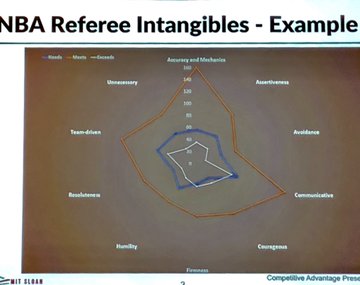
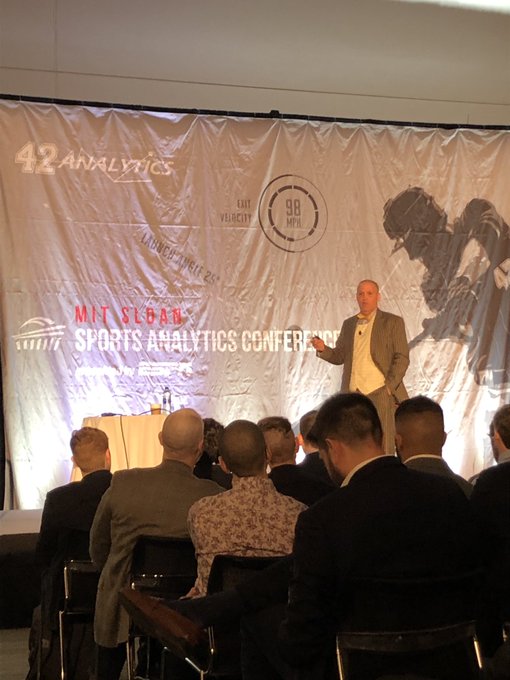
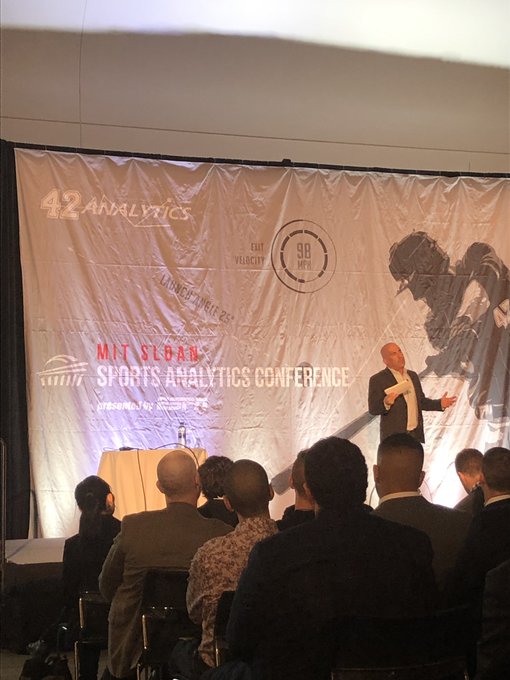
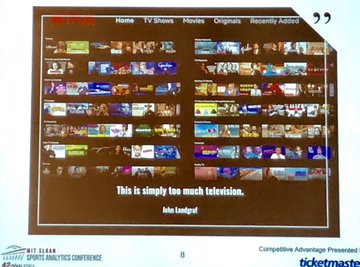
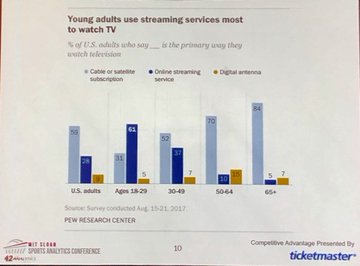
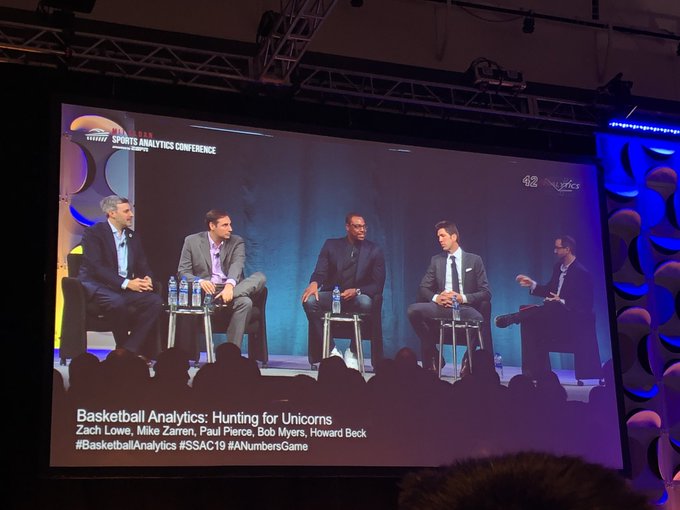
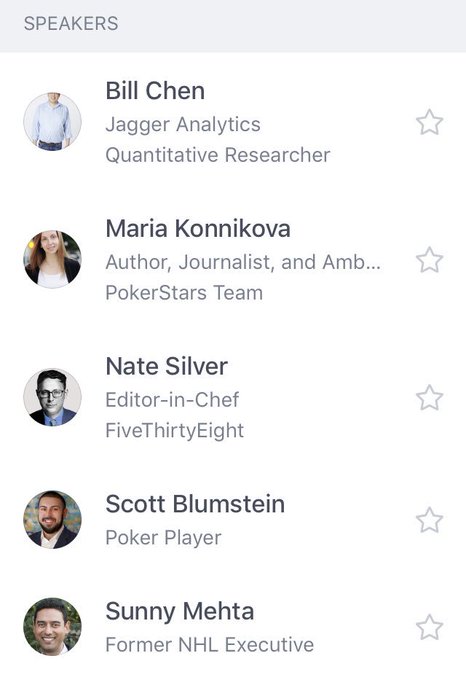
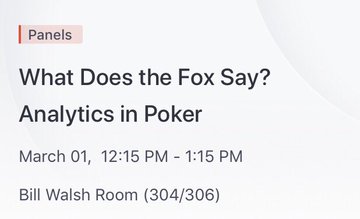
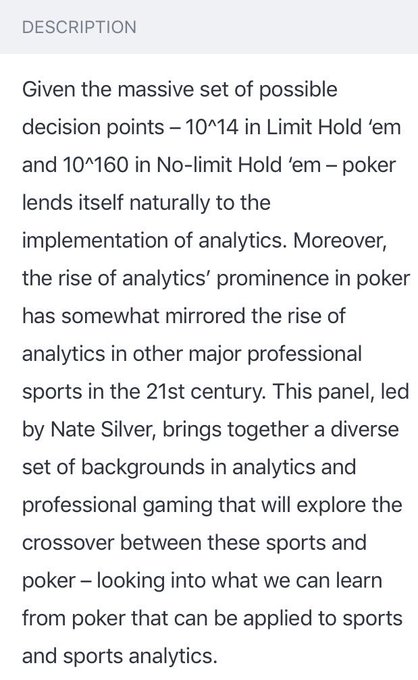
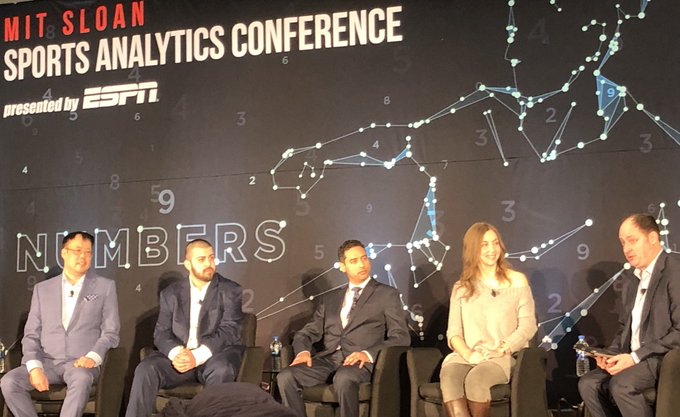
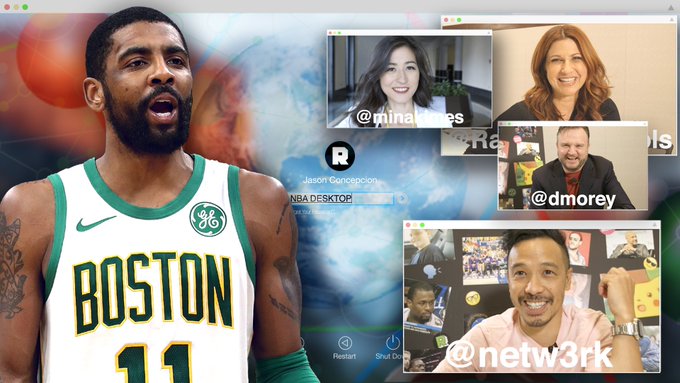
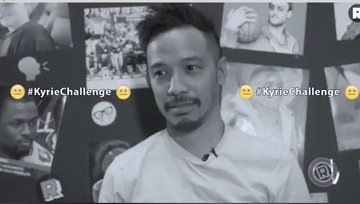
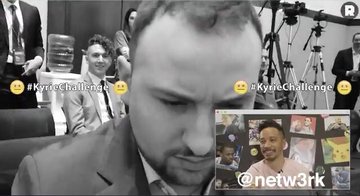
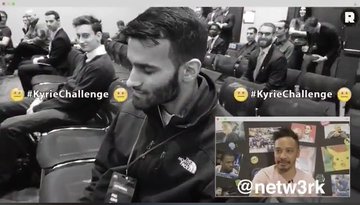
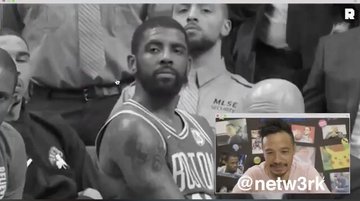

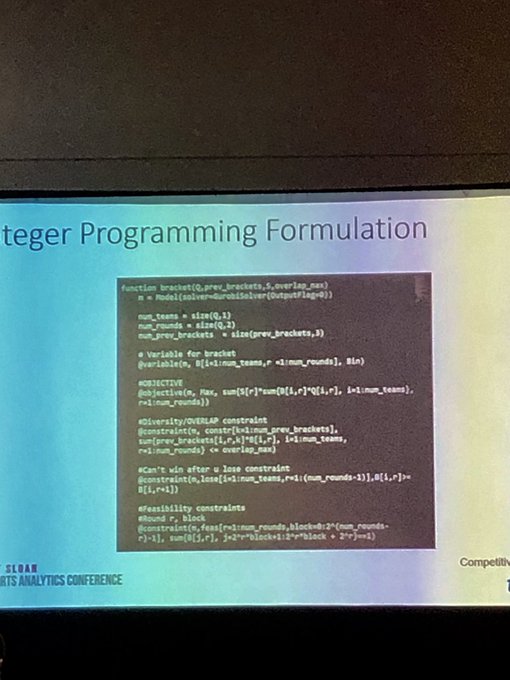
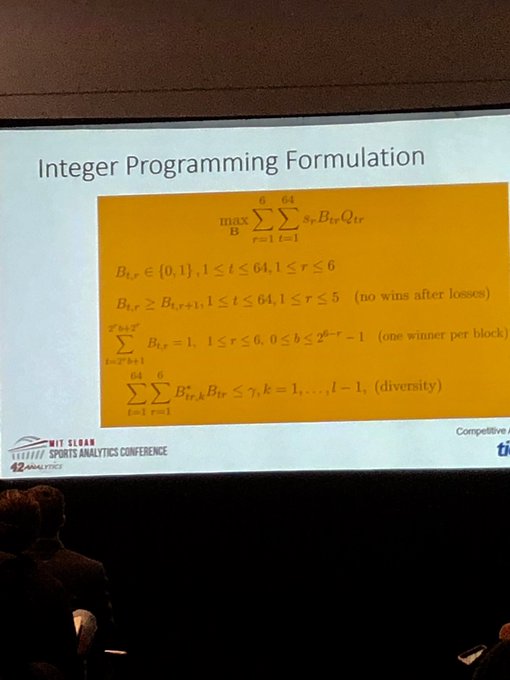

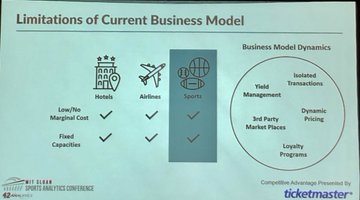

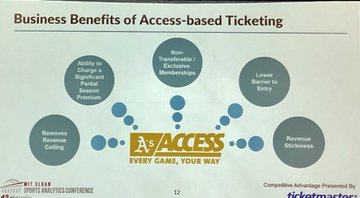

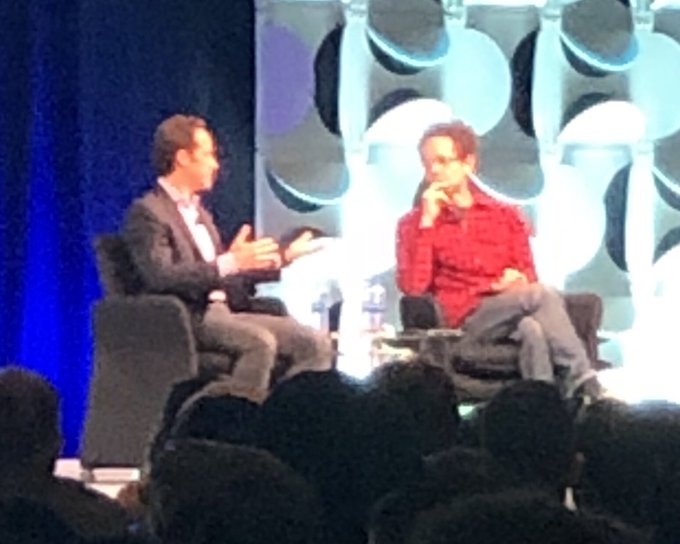

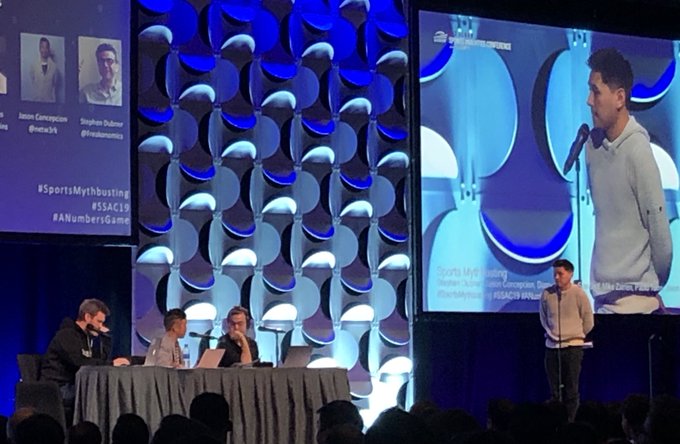
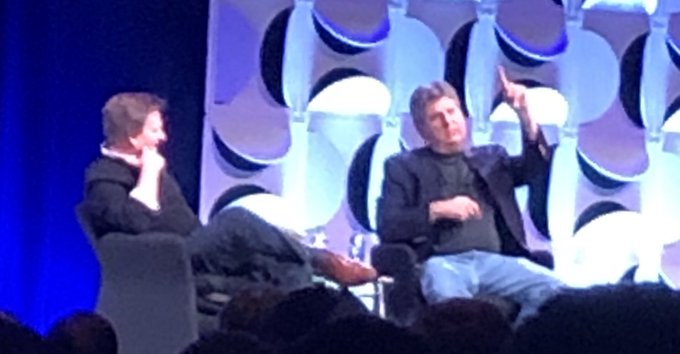
No comments:
Post a Comment